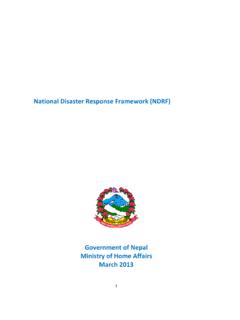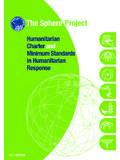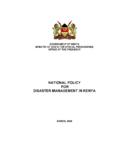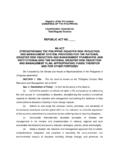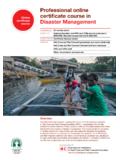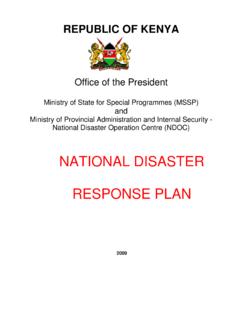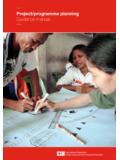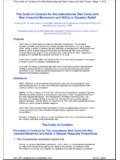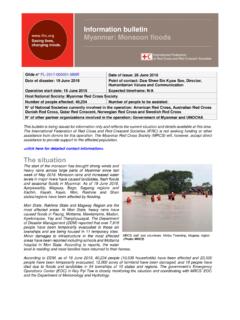Transcription of PMER Pocket Guide Draft 5-2013 - ifrc.org
1 PMER (planning, monitoring, evaluation, reporting) Pocket Guide November 2012 (living Draft ) Planning and evaluation department, Geneva International Federation of Red Cross and Red Crescent Societies (IFRC) IFRC PMER Pocket Guide November 2012 2 | Page TABLE OF CONTENTS TABLE OF CONTENTS ..2 1. INTRODUCTION ..2 2. THE PROJECT CYCLE AND PMER PLANNING ..4 3. INITIAL ASSESSMENT ..5 4. PLANNING PROJECT/PROGRAMME DESIGN ..7 5. BASELINES ..9 6. MONITORING & EVALUATION (M&E) ..9 7. REPORTING .. 13 8. EVALUATION .. 14 THE FUNDAMENTAL PRINCIPLES & CODE OF 15 1. Introduction Purpose and audience The purpose of this Pocket Guide is to provide a user-friendly summary of key PMER concepts and practices for good results-based management of IFRC projects, programmes, and services.
2 Results-based management (RBM) is an approach to project/programme management based on clearly defined results, and the methodologies and tools to measure and achieve them. Good PMER leads to quality RBM, allowing us to: Better implement our programmes and projects towards our shared mission Promote organizational learning and knowledge sharing Uphold accountability and compliance, not only to donors and partners, but the people we serve. Provide opportunities for stakeholder feedback and participation, especially beneficiaries Promote and celebrate our work by highlighting our accomplishments and achievements, building morale and contributing to resource mobilization. The intended audience of this Pocket Guide is people managing projects/programmes in National Red Cross and Red Crescent Societies and the IFRC secretariat.
3 In addition, it has been designed to be understood by other users, including IFRC staff and volunteers, donors and partners. PMER and ethical responsibility The IFRC exists to improve the lives of vulnerable people by mobilizing the power of humanity. The way that we work, including PMER practices, should take seriously the ethical responsibilities that this implies. Project/programme planning should address people s real needs with equity, dignity, and meaningful participation. Monitoring, evaluation, and reporting involves collecting, analyzing, and communicating information about people it is important it is conducted in an ethical and legal manner, with particular regard for the welfare of those involved in and affected by it. Therefore, PMER practices should: Uphold the Red Cross Red Crescent Fundamental Principles and Code of Conduct Respect the customs, culture, and dignity of human subjects Uphold the principle of do no harm.
4 (maximize the benefits and reduce any unnecessary harm) Foster meaningful participation and involvement Ensure that stakeholders can provide comment and voice complaints. IFRC PMER Pocket Guide August 2012 3 | Page Key PMER resources and tools The content of this Pocket Guide summarizes three key IFRC PMER resources and related tools, summarized below. Therefore, remember that further detail on each topic can be obtained in the respective resource. (Note, each title below is hyperlinked to access the publication online when reading in a .pdf format.). Project/Programme Planning (PPP) Guidance Manual Stakeholder analysis SWOT analysis Problem tree analysis Logframe table Project/Programme Monitoring and Evaluation (M&E) Guide M&E plan table Indicator tracking table Project/programme management report template Multiple other M&E templates Framework for Evaluation Evaluation criteria Evaluation standards Evaluation processes Terms of reference IFRC PMER resource websites The above resources and other PMER resources can be accessed online at: IFRC website, This is accessible to anyone, and includes PMER resources.
5 FedNet, (go to National Society Knowledge Development > Planning & Evaluation). This non-public website is accessible only to registered IFRC members and partners. It includes an extensive inventory of PMER resources, including PMER training resources. IFRC s Community of Practice, Here you can find a variety of online forums on topics related to PMER, most notably the PMER Community of Practice, but also communities of practice on Complaints & Feedback Mechanisms, Project/Programme Management Systems. Type in PMER into the Search here space or just browse around. IFRC Online Project/Programme Planning Course, Available on the IFRC s learning platform, through (search for PPP or PMER ). This free online course is made up of two 60-90 minute modules. Pocket Guide feedback This Pocket Guide is a living Draft and will be regularly reviewed, updated, and improved.
6 The scale and scope of PMER at IFRC is such that tools and approaches are often revised or developed. Review and revision of this Pocket Guide will ensure it reflects current PMER approaches, resources, and tools. Feedback or questions can be directed to the IFRC planning and evaluation department, or Box 372, CH-1211 Geneva 19, Switzerland. IFRC PMER Pocket Guide August 2012 4 | Page 2. The project cycle and PMER planning The project cycle The project cycle diagram summarizes some of the major PMER activities that often occur during the project cycle. Note that reporting, learning and reflection can occur at any point in the project lifecycle. These activities are further discussed in this and other IFRC PMER guides, but following is a brief summary: 1.
7 Initial assessment done to determine whether a project/programme is needed, and if so to inform its planning. 2. Logframe involves the operational design of the project/programme and its objectives, indicators, means of verification, and assumptions. 3. M&E planning practical planning to monitor and evaluate the logframe s objectives and indicators. 4. Baseline study the measurement of the initial conditions before the start of a project/programme. 5. Midterm evaluation and/or reviews conducted to assess and inform ongoing implementation. 6. Final evaluation conducted at project/programme end to assess how well it achieved its intended objectives. 7. Dissemination and use of lessons informs ongoing programming modification and improvement. Note: the generic project cycle is useful to represent common PMER activities, but it is important to acknowledge that each project (and programme) ultimately varies according to the local context and need.
8 For example, in emergency operations, actual project start-up may occur before assessment and planning. IFRC PMER Pocket Guide August 2012 5 | Page 3. Initial assessment The initial assessment is done to identify needs/problems, and inform if and what intervention ( project/programme) should be The initial assessments can be conducted in many ways, according to programme context and focus. For instance, IFRC uses Vulnerability Capacity Assessment (VCA), Guidelines for Assessment in Emergencies, while some sectors also have specifically tailored guidelines, such as the Global Food Security Assessment Guidelines. Following are three approaches for initial assessment commonly used at IFRC, each discussed in more detail in the IFRC Project/Programme Planning Guidance Manual.
9 Remember, whichever approach is used for initial assessment, it is important to meaningfully involve local stakeholders during the assessment A) Stakeholder analysis A stakeholder analysis examines different groups of people with an interest in what is being done. It helps to best align an intervention with people s needs, capacities, motivations and commitment. The example table below illustrates one format to examine the main considerations for different stakeholder groups. Example stakeholder analysis table Community leaders Women s groups Schoolchildren National Society volunteers Local authorities Problems Have some responsibility to ensure the safety of the community Do not have enough information to prepare for disaster Vulnerable to disaster and health risks Need better links with community to reduce disaster risk Have to ensure safety of the community Interests Want to ensure safer community Want to get a better understanding of disaster risk Want to be better protected from risk Want to be able to work well with the community Want to demonstrate improvements in community safety Potential Knowledge of the local situation and power relations In-depth knowledge of the community (weather and harvest patterns)
10 Keen to learn and pass on messages Committed and skilled facilitators and community motivators Cooperation and support greatly facilitate project Interaction Through monthly local committee meetings Through monthly women s group meetings Arrange school visits through teachers who are linked to the National Society Through National Society branch structures Through National Society branch structures Others action Also work with the INGO Disaster Relief Action and several church groups Some groups have relations with church groups Many children attend church group activities Good relations between other NGOs and church groups Generally good relations Red Cross Red Crescent action The National Society (Xland Red Cross) has been working for many years across the country with community leaders Currently no active work on disaster management Xland Red Cross has agreements in place with main groups Zland Red Cross (partner National Society) supporting mothers clubs No ongoing projects, good relations with all Red Cross Red Crescent actors Good regular relations with the ICRC and IFRC through Xland Red Cross ICRC and Xland Red Cross have carried out dissemination campaign recently Source.

